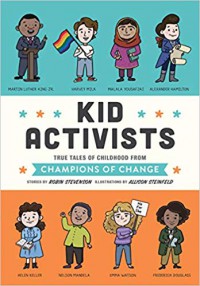Out in Sept

Disclaimer: I recieved an ARC of this book as a freebie in an order I had with Quirk Books.
This is a pretty good luck at the youth of people who became activists and some people who became activists as children. There are total of 16 main biographies as well as a total of 12 secondary mentions. For well known people, such as Rosa Parks, the focus in on thier childhood.
While the majority of people discussed are from the USA, the majority of the people discussed are people of color and women. If the book fails anywhere on representation it is having Helen Keller as the only person with a disability.
It is a children's book so the chapters about famous people - such as King - do not always include the assassination or killing of the person (in some cases this could be because of the person's fame). Hamilton's duel, for instance, isn't dealt with. Additionally, some more complicted aspects of the biographies are left out - such as (understandably) Hamilton's unfaithfulness to his wife and the 180 the woman who taught Frederick Douglass how to read did.
It's true that two of the entries feel a bit like a marketing move - these would be Emma Watson and Alexander Hamilton. Not to say what either did or does is not important, it just seems a bit off, especially in regards to Hamilton.
I really like the inclusion of Autumn Peltier - the First Nations member in Canada who focuses on clean and accesible water. Especially when today it seems as if people think the only child focuses on climate is the girl from Sweden - Greta Thunberg (this is not to diminish what she does). Additionally, Stevenson also presents Nelson Mandela's other names as opposed to just the one US citizens know.
The last section focuses on activists who influenced the world as children in recent years, and includes Iqbab Masin (and mentions his death). The book includes a bibliography section with child-friendly sources on the various people.
The only really weird thing was the illustrations for the Hellen Keller chapter. Overall the illustrations are great. The thing is in the Hellen Keller chapter, the illustrations of Keller keep showing her locking eyes with other people which is a bit strange. I'm not saying she should black holes where her eyes are or anything, but she keeps meeting people's gazes with her eyes.
This is a pretty good luck at the youth of people who became activists and some people who became activists as children. There are total of 16 main biographies as well as a total of 12 secondary mentions. For well known people, such as Rosa Parks, the focus in on thier childhood.
While the majority of people discussed are from the USA, the majority of the people discussed are people of color and women. If the book fails anywhere on representation it is having Helen Keller as the only person with a disability.
It is a children's book so the chapters about famous people - such as King - do not always include the assassination or killing of the person (in some cases this could be because of the person's fame). Hamilton's duel, for instance, isn't dealt with. Additionally, some more complicted aspects of the biographies are left out - such as (understandably) Hamilton's unfaithfulness to his wife and the 180 the woman who taught Frederick Douglass how to read did.
It's true that two of the entries feel a bit like a marketing move - these would be Emma Watson and Alexander Hamilton. Not to say what either did or does is not important, it just seems a bit off, especially in regards to Hamilton.
I really like the inclusion of Autumn Peltier - the First Nations member in Canada who focuses on clean and accesible water. Especially when today it seems as if people think the only child focuses on climate is the girl from Sweden - Greta Thunberg (this is not to diminish what she does). Additionally, Stevenson also presents Nelson Mandela's other names as opposed to just the one US citizens know.
The last section focuses on activists who influenced the world as children in recent years, and includes Iqbab Masin (and mentions his death). The book includes a bibliography section with child-friendly sources on the various people.
The only really weird thing was the illustrations for the Hellen Keller chapter. Overall the illustrations are great. The thing is in the Hellen Keller chapter, the illustrations of Keller keep showing her locking eyes with other people which is a bit strange. I'm not saying she should black holes where her eyes are or anything, but she keeps meeting people's gazes with her eyes.
Break Down (informal)
Main Biographies: 16
Male: 7
Female: 9
POC ; 11
LGBT+ 3
Disabled: 1
USA: 11
South Africa, England, Pakistan, Canada : 1 each
First Nation/Indigenous: 1
Secondary People (mentioned after main chapters)
Total: 12
Male: 4
Women: 8
POC: at least 6
LGBT+ - 3
USA- 9
South Africa, France, India - 1 each








